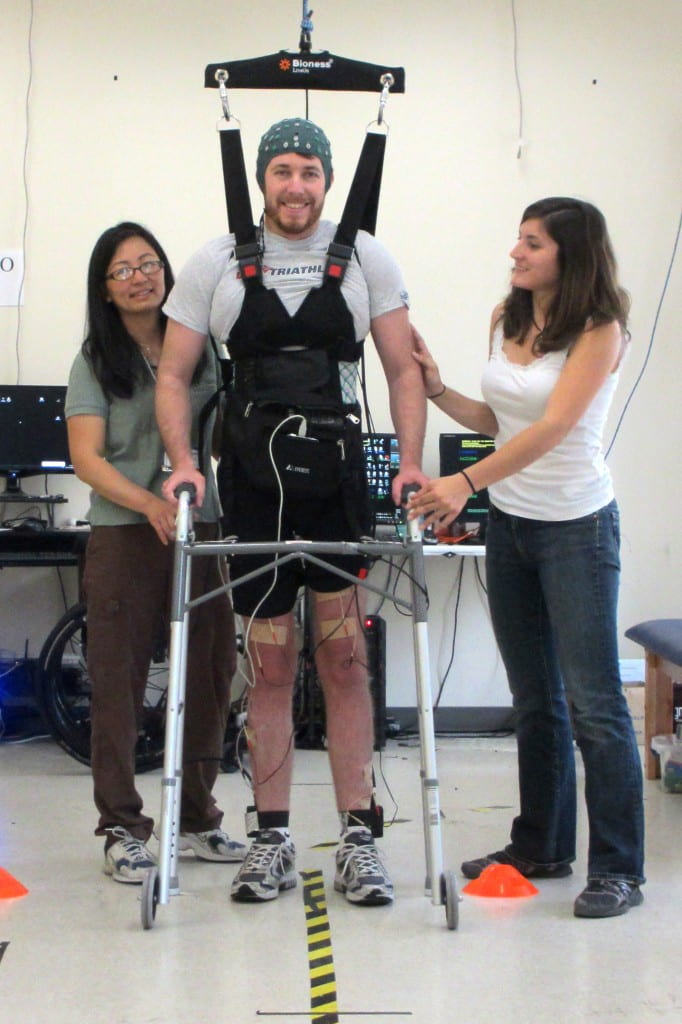To walk again
UCI brain-computer interface enables paraplegic man to take historic steps

To paraphrase a famous saying, it was 12 small steps for one man and one giant leap for research aiming to help people with spinal cord injuries.
Adam Fritz – whose legs are both completely paralyzed – recently employed novel brain-computer interface technology created by University of California, Irvine researchers to do what no paraplegic had ever done before: use the strength of his mind alone to take those historic steps.
Fritz’s short walk is part of a proof-of-concept study led by UCI biomedical engineer Zoran Nenadic and neurologist An Do to test an electroencephalogram-based system in which the brain bypasses the spinal cord to send messages directly to the legs.
Study results appear in the open-access Journal of NeuroEngineering & Rehabilitation (www.jneuroengrehab.com).
The technology works by taking electrical signals from the subject’s brain, processing them through a computer algorithm, and firing them off to electrodes placed around the knees that trigger movement in the leg muscles.
“Even after years of paralysis, the brain can still generate robust waves that can be harnessed to enable basic walking,” says Nenadic, an associate professor of biomedical engineering. “We showed that you can restore intuitive, brain-controlled walking after a complete spinal cord injury. This noninvasive system for leg muscle stimulation is promising and an advance of our current brain-controlled systems that use virtual reality or a robotic exoskeleton.”
Grueling months of mental training to reactivate the brain’s walking ability – in addition to physical therapy – were needed for Fritz to reach the stage where he could take steps. Outfitted with an EEG cap to read his brain waves, he was first asked to think about moving his legs. This may have been the hardest part of the study, Fritz says, because the brain region where these electrical signals occur had been dormant since his injury seven years earlier.
The brain waves created by his thinking were processed through a computer algorithm Nenadic had formulated to isolate those related to leg movement. Fritz later was taught to control a video-game-like avatar in a virtual reality environment, which validated the specific brain wave signals produced by the algorithm.
This training regimen yielded a custom-made system, Nenadic says, so that when Fritz sought to initiate leg movement, the computer algorithm could process his brain waves into electrical signals that could stimulate his leg muscles.
To make this work, Fritz required extensive physical therapy to recondition and strengthen his leg muscles. Then, with the EEG cap on, he practiced walking while suspended 5 centimeters above the floor, so he could freely move his legs without having to support himself. Finally, in the iMove lab – which is located in UCI’s stem cell building, Sue & Bill Gross Hall: A CIRM Institute – he translated these skills to the ground, wearing a body-weight support system and pausing to prevent falls.
“Because of my injury, I had no sensation in my legs, but I could feel the impact of each step moving up my body,” says Fritz, 28, who injured his spinal cord in a motorcycle accident. “It was nice to feel that again.”
Since this study involved a single patient, Do notes, further research is needed to establish whether the results can be duplicated in a larger population of individuals with paraplegia.
“Once we’ve confirmed the usability of this noninvasive system, we can look into invasive means, such as brain implants,” adds Do, an assistant clinical professor of neurology. “We hope that an implant could achieve an even greater level of control because brain waves are recorded with higher quality. In addition, such an implant could deliver sensation back to the brain, enabling the user to feel his legs.”
For this next phase of research, count Fritz in.
“There are huge steps that still need to be made, but it’s on the way, going in a good direction,” he says. “Anything I can do to help, I’ll do.”
Christine King, Po Wang, Colin McCrimmon and Cathy Chou of UCI contributed to the study, which received support from the National Science Foundation.